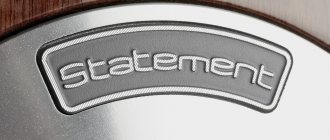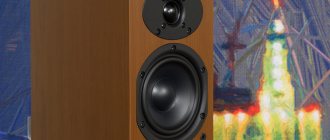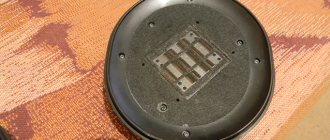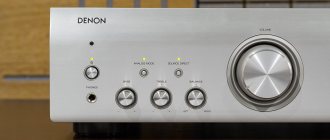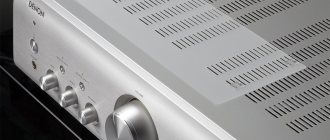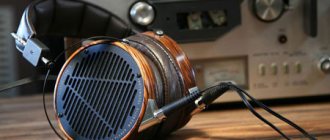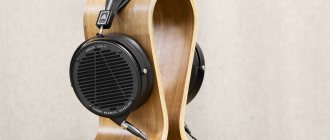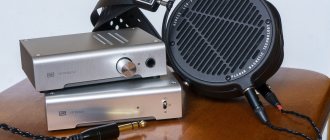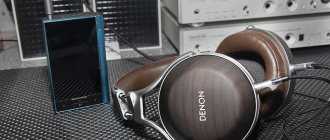Hi-End headphones. Reference quality
Denon's new flagship headphones, the AH-D7200, are the result of more than 50 years of experience in headphone design and manufacturing. Five decades of experience have resulted in comfortable, great-sounding headphones you won't want to take off. These headphones feature unique Japanese-made FreeEdge speakers that deliver ultra-accurate audio reproduction. The speakers are secured through a special anti-vibration panel in a housing made of real walnut, which also dampens internal resonances. The detachable 7N high-purity copper cable, made in Japan to Denon specifications, provides the best sound transmission and features durable metal connectors. The ear pads and headband are lined with premium soft leather, and the ear pads have memory foam for natural comfort. Every element of the uncompromising design of these headphones is aimed at the highest sound quality and comfort, resulting in the ultimate listening experience to the music you love.
Repetition of what has been covered
The history of Denon's modern line of flagship headphones spans nine years, but includes only three models. Information on all three is widely available, and I remember the previous flagship quite well from a test five years ago. Using this, let’s see how Denon’s idea of high-quality headphones has changed over nine years.
It's no secret that over the past time the manufacturer has clearly become more practical and economical. The first and second models were delivered in expensive luxury boxes with leather trim and a backing covered with satin fabric. In such a pretentious way one could pack not only expensive headphones, but also some designer accessories or jewelry.
The equipment is extremely modest: one cable with a 6.3 mm connector and a microfiber cloth
The new AH-D7200 does not have this luxury. A completely ordinary black box made of thick cardboard with a polyurethane foam tray is more typical for premium models. Apparently, Denon marketers have come to the conclusion that this makes no sense and does not provide value to the buyer. There is a logic here: focusing on sound, you shouldn’t distract people with excessive luxury packaging. Otherwise, they will think that the manufacturer saved money on the speakers for the sake of the satin backing, and they will choose a model that is packaged more brutally.
In the second version of the headphones, in addition to the luxurious box, there was also an attempt to charm the buyer with a rich package. The AH-D7100 headphones came with two cables: one for stationary equipment and the other for portable equipment. Plus a bag with a carabiner for carrying and even a table stand.
The new AH-D7200 is equipped with minimal equipment. There is one long cable with a 6.3 mm jack and a microfiber cloth for cleaning the headphones. There are no other accessories offered, and this, in my opinion, is also overkill. It felt as if the restaurant served steak and fork, but forgot about the knife. If not a cable, then at least an adapter for a 3.5 mm jack could have been added to the kit?! I won’t even mention a balanced cable; you’ll have to buy it, just like a stand.
Unlike the packaging, the appearance of the headphones themselves leaves no doubt about their high cost.
If we compare the appearance, the similarity of the AH-D7000 and AH-D7200 models is quite obvious, and the new product has nothing in common with the fashionable design of the AH-D7100, except perhaps the logo and the material of the cups.
Looking at this, it is not difficult to understand the main essence of Denon's reboot: an end to competition with manufacturers of large and expensive plastic headphones and a return to the traditional values of the hi-fi world. Connoisseurs of the classic approach will undoubtedly be pleased, although I liked the unusual design of the AH-D7100 model, and the sound, which, by and large, did not have such radical differences from the AH-D7000 model, popular among audiophiles.
Sound for one
A distinctive feature and one of the most important competitive advantages of the Denon AH-D7200 is its closed design. It just so happens that High End, with few exceptions, have an open design, which means that you can only enjoy your favorite music in silence. So that no one around makes noise and speaks at the loudest level - in a whisper, like in a library.
The headband is as fluffy and soft as the ear pads, providing comfort for long periods of listening.
The closed design is considered a compromise in terms of quality of sound stage transmission, but its undoubted advantage is the user’s independence from the surrounding environment. Your household can relax and stop tiptoeing around silently while you enjoy the music. Why, with ear pads like those of the AH-D7200, even a low-volume TV will not disturb audio nirvana. This is indeed a big plus, and the developer promised to compensate for the typical disadvantage of closed headphones, the narrowness of the stage, with special internal damping.
What happens in practice? In practice, the soundstage is actually quite wide, especially in the high frequencies. The middle sounded more crowded, but this was apparently a consequence of the headphones warming up for a short time in my case. They worked for several hours before the test, and the owners of this and similar models talk about full sound development after 100-200 hours of operation. Anyway, the scene is already good enough. Not like the open ones, but better than expected.
The closed design has its advantages even for home use
The tonal balance is dark, there is a feeling that the headphone output decreases with increasing frequency, which adds bassiness and heaviness to any music. This can be easily felt in comparison with smooth studio headphones, but it is unlikely that the AH-D7200 will stand out from the general range of home models. Such an imbalance in the frequency response has long been perceived as the norm. In addition, this approach makes the vocals warm, and the overall character of the sound - calm, soothing, which is perfect for simple jazz, classical, leisurely blues and other audiophile pleasures.
The timbres of live instruments and voices are transmitted quite naturally and richly. The level of detail is high, as you would expect when you have a design on your head that costs more than fifty thousand rubles. The sound cannot be called perfectly smooth or monitor-like, but it is definitely comfortable and “tasty.”
Fabric braiding is not very practical, but it looks expensive
Warm, lively mids, pleasant enveloping bass and open, unobtrusive highs encourage long listening without straining and searching for details and special sounds. “Musicality” is probably the most accurate definition of the sound character of this model.
But there are still some genre restrictions. Most likely, due to the insufficient heating of the speakers, the middle was somewhat compressed, so a dense and energetic guitar sound in the spirit of ZZ Top and White Stripes or an assertive beat like Swanky Tunes sounded uncomfortable. In a word, you should start with lighter and unobtrusive music, and only then, as you warm up, you can move on to something heavier.
The manufacturer does not intend to use such headphones with a portable device, but in vain. Sometimes it would be nice to take a walk with a hi-fi quality soundtrack
From purely technical observations, I note that the Denon AH-D7200 turned out to be demanding on the quality of the source and amplifier in the sense that they are able to reveal all their shortcomings. For example, the headphone output of the proprietary integrated amplifier produced a pale sound with low detail and a narrow soundstage. And the good-sounding Wileyfox Swift smartphone, although it did not greatly surpass it in detail, still produced a more interesting, lively and full-fledged sound, with adequate volume and an even tonal balance. Perhaps the AH-D7200 would work very successfully with a good portable player, but the cable would have to be changed, an adapter from 6.3 to 3.5 mm is clearly not an option.
Stereo headphones Denon AH-D7200
If you follow how the design and market positioning of headphones has changed in Denon’s top-end “seven thousandth” series, which debuted back in 2008, then an uninitiated music lover may have many questions. Let's try to give answers, getting acquainted with the latest and most advanced model along the way.
Denon has been developing headphone technology for fifty years. At first, they did not go beyond the narrow framework of specialized equipment for laboratory and professional purposes. The breakthrough into the wide hi-fi market took place much later, in the early nineties, when the company introduced a whole range of headphones and even released a separate catalog. And five years ago, when the demand for personal audio began to grow at the same rate as digital audio players and smartphones were being sold out, Denon decided to divide all produced models into “sports”, “urban”, “road” and “manic”. We are interested in the latter, or more precisely, in the absolute peak.
Denon only introduced it with the release of the AH-D7000. The high-end model was created in cooperation with Fostex, a recognized Japanese pro-audio manufacturer. Around the same historical period, this partner began to offer closed-back headphones from the audiophile TH Premium series, with a very similar design and identical characteristics. They, like the Denon model, used 50 mm speakers with membranes made of a composite of bio- and mineral fibers. In this way, it was possible to obtain diffusers that were highly rigid for their insignificant weight, but at the same time did not have a pronounced resonance of their own. I will not specify which company acted as an OEM supplier and was the author of the technology. It is important, firstly, that it is considered one of the most advanced, and, secondly, it is precisely this that allowed Denon to immediately rise to the ranks of manufacturers of top-class headphones.
The company has returned to the previous classic design: wooden cups, improved headband attachment and an arc adjustment mechanism. Everything was done so carefully and reliably that a mosquito wouldn’t hurt your nose.
And then this happened: seeing in what incredible quantities some of the majors were selling bright and stylish models, Denon management decided to reposition the Music Maniac series as a designer one. The new flagships AH-D7100 come out in an unexpectedly catchy design, which, of course, was too bold a decision. Can you imagine headphones for 1000 euros with amazing sound in a youth-mobile style?
Now we look at the AH-D7200 and rejoice! The company has returned to the previous classic design: wooden cups, improved headband attachment and an arc adjustment mechanism. Everything was done so carefully and reliably (at least in appearance) that a mosquito wouldn’t undermine your nose. The ear pads are much neater than their predecessors. The rollers themselves are also optimal - both in shape and in the rigidity of the foam filler, which remembers the shape. I am not upset that the kit does not include a 6.3/3.5 adapter - Denon once again emphasizes that the product is intended for home use. The presence of standard 3.5 mm jack sockets in the cups is also welcome - there will be no problems with selecting another cable if for some reason the standard three-meter wire made of copper with 7N purity is not suitable.
The differences from previous models come down to the material of the cup bodies - instead of mahogany, a special type of walnut is used. The heads feature the same 50mm FreeEdge nanofiber diaphragms found on the AH-D7100, but the increased bandwidth and increased sensitivity at least indicate changes in the design of the neodymium magnetic system.
Every time I put closed phones on my head, I dream of a miracle - not to hear the “sound of the sea.” Headphone manufacturers have made great progress in suppressing the unwanted acoustic effect of closed cavities, but still not completely. So the AH-D7200 gives a light “shell” color, which, however, is exactly how it should be interpreted - it has nothing to do with obvious internal resonance. This means that after two to three minutes of adaptation, our hearing will “subtract” the undesirable phenomenon with absolutely no consequences for listening comfort and sound intelligibility.
Signs of compression are not audible at all - the drum roll is “imprinted” with extreme realism, low drums are transmitted with good energy...
And you pay attention to this from the very first minutes! The clarity of details, expressiveness and naturalness of timbres are expressed to such a clear degree that you simply don’t want to focus on other characteristics. Signs of compression are not audible at all - the drum roll is “imprinted” with extreme realism, low drums are transmitted with good energy, in all “power” gradations and even with some correct vibrations without an intrusive compression effect (which, however, will not appeal to fans of clapping bass ears). Everything is clean in the top lane. I listened to a lot of tracks, trying to find any favorite tones in the highs from the AH-D7200, but I couldn’t find a single pronounced “whistle”.
In the end, there are only two complaints. The first is to interpret the lower middle. Closed-back headphones are not characterized by “blurring” of this band, but here something similar happened - I wanted a more pronounced texture. The second is to space. The scale and location of sound images in an apparent scene is determined not by the illusion of their distance, but by a banal shift to the left and right and intensity. However, this effect is generally typical for closed structures.
All of the tests described above were performed with headphones connected to a Denon integrated amplifier. If you take a signal directly from a source, where it is amplified, as a rule, by a path using specialized op-amps, formally you don’t lose much in sound quality (this is critical for compatibility with portable equipment). Dynamics, purity and even detail are preserved, and only the harmonic coloring is weakened. The bass becomes overly flexible and heavy, and the mids become a little “watery”.
When switching to a McIntosh integrated device, the telephone output of which is not much inferior in class to a special “ear” amplifier, exactly the opposite happens. The playback becomes more vivid, and the signature of each acoustic instrument becomes clearer. The entire midrange reveals itself deeper and more aesthetically, and this also applies to its low-mid range, which in itself is a very good sign. If the previously noticed problems are not repeated with another amplifier, and the phones, in principle, cannot be blamed for any “gag,” then this means that you are dealing with equipment that is actually close to the reference class.
The entire midrange reveals itself deeper and more aesthetically, and this also applies to its low-mid range, which in itself is a very good sign.
Stereo phones Denon AH-D7200
Manufacturer: D&M Holding Inc (Japan)
www.denon.ru
Resistance: 25 Ohm || Design: closed || Playback range: 5 - 55000 Hz || Sensitivity: 105 dB/mW || Power supply: up to 1800 mW || Weight: 385 g || Price: 59990 rub.
COMPONENTS
- Sources: Apple MacBook Air A1465 laptop
- turntable McIntosh MCD550 and Denon DCD-1600NE
- digital Blue Dual Shield USB 2.0 AB
share
Tags: AH-D7200AppleBlue Dual ShieldDenonInAkustikMcIntoshobzory
Design features
And yet, despite the return to simplicity and functionality, some attempts to make the headphones more attractive in appearance can be seen in the AH-D7200 model. Contrasting diagonal stitching of the headband leather, more elegant fastenings of the ear cups - all this is done, of course, for beauty and could be much more utilitarian.
The design of the new version is not without grace and style
The assembly and workmanship of the headphones are impeccable. Hand-polished wooden cups are not only pleasant to look and feel, but also have good anti-resonance properties, in addition to which there are special components that dampen the internal volume.
The main load-bearing and hinge elements are metal - the design is reliable and durable. The large size and round shape of the cups is compensated by lush asymmetrical ear pads with an oval-shaped interior. Thanks to the ability to rotate the earcups in two axes and step-by-step adjustment of the headband, the AH-D7200 sits very comfortably. The ear pads and top cushion distribute considerable weight evenly.
The internal space of the ear pads follows the shape of the ear, and the fluffy pillow around ensures a comfortable fit to the head.
The cable connection is two-way, implemented on monophonic 3.5 mm connectors. I like this option more than others because the connector is quite simple, reliable and, most importantly, widely available. There should be no problems with selecting alternative cables, although the manufacturer has done everything so that you don’t even think about it. The complete cable is made of high-quality Japanese copper of the highest purity grade 7N.
TS 3.5 mm type connectors (monaural mini-jack) are reliable and quite common
The speaker has a cellulose nanofiber cone made using FreeEdge technology. It is a dense and rigid material that is lightweight and has a high degree of internal damping. Visually, it resembles ordinary paper, as far as can be seen through the fine metal mesh covering the diffuser. The declared load capacity of the headphones is impressive: 1.8 W. And the declared impedance is very modest, more suitable for working with portable equipment - only 25 Ohms.

